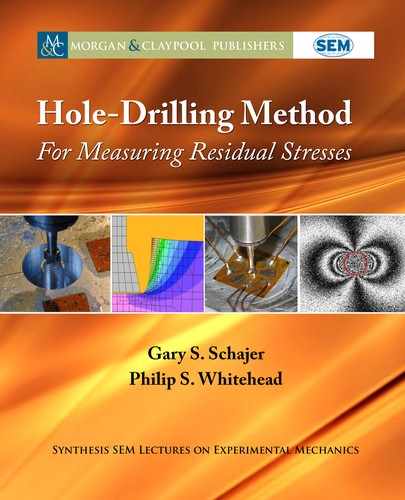
14 1. NATURE AND SOURCE OF RESIDUAL STRESSES
1.5 EFFECTS OF RESIDUAL STRESS
Residual stresses can be beneficial or harmful depending on their character and distribution.
Uncontrolled residual stresses that are large both in magnitude and in spatial extent are typically
detrimental. Because of the large thermal gradients that occur during their manufacture, castings
typically contain large residual stresses. In extreme cases, this causes the cracking illustrated in
Figure 1.6. e geometry of cast metal components is commonly designed to ameliorate either
the size or effect of residual stresses, typically by the inclusion of generous fillets to minimize
stress concentrations and by the choice of favorable geometric features. Figure 1.11 illustrates
a cast flywheel designed with curved spokes. At first glance, the spoke shape seems to be a
decorative feature, but actually is deliberately designed to increase elastic flexibility within the
wheel and thereby reduce the effects of the residual stresses that are inevitably present. Large
fillets are also evident at the spoke connections.
Figure 1.11: Curved spokes used to reduce residual stresses in a cast iron flywheel.
Commonly, surface compressive stresses are beneficial because they close any surface
cracks that are present and thereby increase the strength of brittle materials. e thermally
toughened glass shown in Figure 1.1 is an example where surface compressive stresses are de-
liberately introduced to enhance material strength. Shot-peening is a further example of such
material treatment. In that case, small hardened balls are blasted onto the material surface to
cause local plastic deformation and induce surface compression. Pre-stressed concrete is used
for broadly the same reason, where the steel reinforcing bars are deliberately tensioned so as to
draw the surrounding brittle concrete into compression.

1.5. EFFECTS OF RESIDUAL STRESS 15
In contrast, tensile residual stresses are harmful in brittle materials and in materials prone
to stress corrosion cracking. ey are also harmful in materials subject to repeated loading be-
cause their adverse effects on fatigue life and/or allowable alternating stress amplitude. e
Goodman and Gerber diagrams used for fatigue design highlight this fundamental effect. e
associated loss of fatigue load capacity coupled with the “hidden” character of residual stresses
can lead to unexpected structural failures, sometimes on a large scale and with very serious con-
sequences. For example, residual stresses in a cast eyebar link were a major factor in the 1967
failure shown in Figure 1.12 of the U.S. 35 Silver Bridge in West Virginia. e collapse caused
the loss of 46 lives.
Figure 1.12: Section of U.S. 35 Silver Bridge that collapsed in 1967 due to crack propagation as-
sociated with residual stresses (photo courtesy of U.S. Dept. of Transportation, Federal Highway
Administration).
Wood is an unusual material because cell wall buckling causes it to behave oppositely to
brittle materials and to have a compressive strength significantly lower than its tensile strength.
In that case, the presence of tensile stresses at the surface can be advantageous, causing several
species of trees to develop “growth stresses.” ese naturally occurring residual stresses comprise
axial tension around the outside of the tree, balanced by axial compression in the interior. Wind-
induced bending applies symmetrical tensile and compressive axial stresses that are largest at the
outside of the tree. e presence of the growth stresses biases the surface stresses toward tension,
thus mitigating the lower compressive strength. Figure 1.13 shows a eucalyptus tree after felling.
..................Content has been hidden....................
You can't read the all page of ebook, please click here login for view all page.
